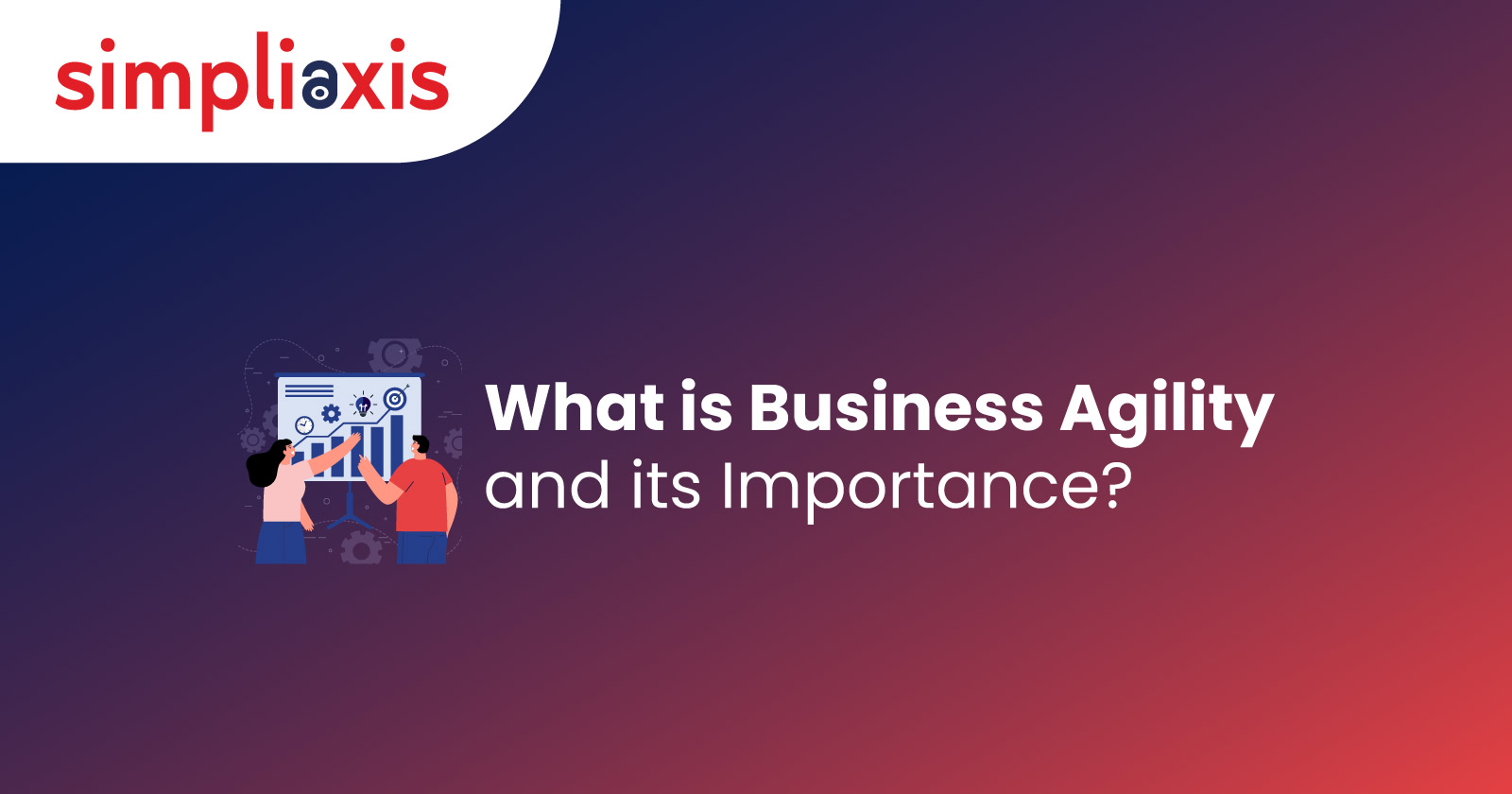The year 2020 proved that nothing is guaranteed in life, even to the extent that a virus had the potency to disrupt our normal living ways. Most of us were fast to accept the changes and adapted to the new ways smoothly. The same is the story of the commercial business world. Things would always be hunky-dory in the utopian context, and businesses would only be stable and growing. But, this is not a perfect world. Market dynamics keep changing, and there are rapid lows and ups through which business establishments need to sail. Only Agility helps businesses stay afloat and weather the storm.
So, what is Business Agility, after all?
The definition from Scaled Agile Framework is, “the ability to compete and thrive in the digital age by quickly responding to market changes and emerging opportunities with innovative business solutions, is business agility.” It further states that every unit in a business entity involved in delivering a solution – business leaders, IT heads, software development and operations, sales and marketing, finance, customer support, legal and compliances, and security need to use Agile practices. It is important to keep innovating and delivering optimized product quality with enhanced speed to be ahead of the competition.
What it necessarily means is that businesses should always have a survival plan to overcome any volatile changes or disruptions in the market. With business agility, they can optimally do so.
Agile businesses found it easier to work with complex technological projects, especially in a market where the environment is rapidly changing. Later, the framework was extended to all types of enterprises, government institutions, profit, and non-profit organizations.
Pillars of Business Agility
There are three pillars on which agile businesses carry forth their functioning
- Being flexible and adaptable to changing needs.
- Being innovative and investing in co-evolution
- Maintaining a balance between organizational goals and delivering values to customers.
Business agility emphasizes delivery agility characterized by fast and responsive delivery, innovating and disrupting organizational adaptability, and display leadership effectiveness through all the complexity.
The crux of Business Agility
So, what is that one thing that lies at the center of an Agile business? It is customer-centric functioning. The Agile framework believes in the age-old practice of ‘customer is the king’. Agile businesses take extra efforts to comprehend customers’ needs, empathize with them, and promptly deliver what they want. Agile businesses are quick to respond to their customers’ needs and requirements!
Importance of Agility in business with statistics to prove
- 92% of senior executives globally believe that organizational ability is crucial for the business’s success.
- Agile organizations are likely to achieve optimized quartile financial performance compared to average organizations. It is 55% for the former to 25% for the latter.
In the Business Agility Report – Responding to Disruption, 3rd Edition, 2020 by Accenture, 433 respondents from 359 organizations across 53 countries and 28 industries were asked about their experiences, progress, and insights about their Agile journeys. It was noted that an increasing number of organizations had undertaken the Agility journey while those organizations that were already on the road reported enhanced progress. Some of the key findings reported were:
- The year-on-year growth in the maturity levels of business agility is 8%.
- The pandemic influenced the maturity levels too. North America reported a decrease of 10% while the rest of the world reported an average increase of 15%.
Understanding the importance of agility in business, the survey found that most respondents shared that their enterprises were well-equipped to face the aftermath of the Covid-19 because of business agility. The significance of agility was summarized under these heads:
- Commercial benefits, which emphasized the readiness to deliver products fast and as per customer satisfaction.
- Organization benefits that saw augmented collaboration and communication.
- Benefits to the workforce that focused on employee morale and motivation.
- Enhanced adaptability, especially in terms of adapting to the Covid-19 situation.
The leading predictors of business agility were found to be:
- Relentless or continued improvement facilitates learning and experimentation to minimize costs, enhance efficiency, and deliver higher values to customers.
- Funding models that empower businesses to identify opportunities and make investments in newer products and services.
- Value streams lead to value creation because work is customer-centric.
- Of the industries covered, IT and Consulting had 26% respondents, FS and Insurance had 18%, Manufacturing & Automotive & Aerospace had 7%.
Finally, the top reasons for organizations to adopt business agility were summarized as:
- Cross-functional collaboration and interpersonal communication
- Improved working ways
- Speed, faster turnaround time, and capability to customized solutions.
- Customer satisfaction helps improve market performance.
- Ownership accountability
- Agile Mindset
- Adaptive Leadership
- Motivation
- Employee satisfaction
Benefits of Business Agility
1.Staying competitive
Agile businesses are oiled and geared to have a competitive advantage. Because Agile companies can adjust their working with changing customer needs and demands, they can take advantage of short-term opportunities that keep cropping up, time, and again. It is imperative to remember here that Agile businesses are characterized by speed to market. That is why they can make rapid responses, utilize opportunities, and remain at the top of the market.
2.Customer-centric businesses
One of the biggest benefits of business agility is that Agile frameworks help businesses be completely focused on their customers. Customers today are well-informed, have access to the latest tools and technologies, and therefore demand their needs and requirements. Therefore, businesses need to ensure that they can swiftly respond to the evolving needs and demands of customers. Compared to traditionally bureaucratic organizations, Agile enterprises are well-equipped to respond to the preferences of their customers.
3.Teamwork and collaboration at peak
Agile organizations encourage cross-functional teams to work collaboratively. Traditional organizations have varied teams and departments working in silos; as stand-alone units. Therefore, a lot of time is used up in understanding team dynamics and getting the boat sailing. On the contrary, Agile businesses work on cooperative collaboration principles with teams consisting of cross-functional teams. Thus, there is an environment that is filled with creativity and innovative thought processes.
4.Enhanced business value
One of the core deliverables of Agile businesses is that the business stakeholders deliver optimized business value. The involvement of stakeholders helps Agile teams understand business goals and missions clearly and prioritize critically important issues. Agile teams are equipped to prepare features that bring in most business values to their business model.
5.Enhanced quality of products and services
Agile frameworks help deliver enhanced product quality. In Agile frameworks, the entire project is broken down into small Sprints or manageable units. Each of these Sprints has specific Sprint goals that are prepared based on changing customer needs. Also, Sprints are small-sized and shorter in duration. The entire product lifecycle from designing to development to testing and launching happens within these small units. All of this helps deliver products that are high in quality.
6.Brings in transparency
Business Agility means that all the relevant stakeholders are involved in the project. There are end customers, leadership teams, different functional teams, and departments – all of this helps create a transparent working system. From prioritizing features to planning iterations and reviewing features, a unique openness peps up confidence levels in the team and everyone concerned with the project.
7.Predictable delivery schedule and costs
With every spring being small and of designated duration in an Agile environment – Sprints usually last for four weeks or could be shorter – deliveries are faster, prompt, and most of all predictable. Thus, there is zero ambiguity, which is good for everyone around. Not only that, even the costs associated with product development and launch can be predicted with accuracy. It is also because the work is all time-boxed. Most of the work in Agile environments starts with estimates before a sprint. Since the Sprints are time-bound and small-sized, estimating approximate costs becomes an additional benefit of business agility.
8.Boosts employee morale
With a dynamic working environment with faster deliveries, reduced costs, and improved productivity, employers can enhance their morale levels. There is higher participation from employees across multi-departments and multi-teams. Business Agility directly implies taking inputs from employees, regular giving and taking feedback, a continuous process of improvement flow sets in. All of this directly impacts the performance of employees and the organization as a whole.
Also, check :Best Ways to Improve Business Agility
Conclusion:
In conclusion, business agility is paramount in today's unpredictable world. Defined as the ability to swiftly respond to market changes, it's crucial for success. The pillars of flexibility, innovation, and alignment guide agile businesses. Through customer-centricity and collaboration, they not only weather storms but also seize opportunities. Statistics highlight the financial benefits of agility, with agile organizations outperforming others. Agility empowers companies to stay competitive, customer-focused, and innovative, enhancing overall value and morale. As businesses navigate complexities, embracing agility is essential for sustained growth. Simpliaxis offers agile project management solutions to empower businesses in this journey






















